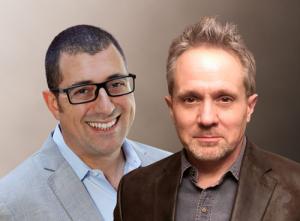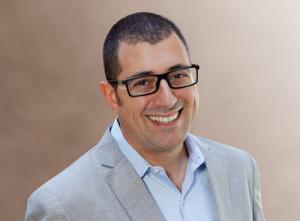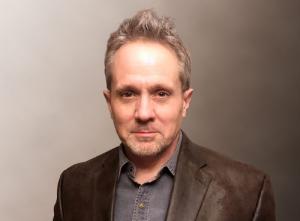Facing Headwinds
Itai Dadon is global head of smart city product marketing at Itron.
Dan Pfeiffer is vice president of government affairs at Itron.
Recently, Public Utilities Fortnightly's editor-in-chief Steve Mitnick sat down and had a talk about smart communities with Itai Dadon, global head of smart city product marketing at Itron, and Dan Pfeiffer, vice president of government affairs at Itron. They had a lot to say about Itron's deep involvement in the hard work required to smarten communities. Here are some excerpts from that conversation.

PUF's Steve Mitnick: What's the business case for smart communities?
Itai Dadon: What we've seen is that the market is not slowed down by technology; it is slowed down by the lack of creative business models and financing. Cities and utilities need more formalized and more clearly defined business cases for each one of the smart city applications available today.
As applications mature and we have access to more data, we better understand the value of these applications, which helps strengthen the business case. With this, it becomes easier to secure financing for new deployments, whether it's from investors, cities, utilities, or another private entity.
The benefits of a smart community application come in three phases. First, there is the direct benefit of the actual application. Typically, the city or utility knows in advance what objectives they want to achieve. For example, when a city puts a parking solution in place, it knows that it wants real-time communication with the citizen on where parking spaces are available in order to reduce traffic in the city and improve the citizen's experience. So, more people park faster, which results in more payments coming in for the city, fewer requirements for parking enforcement, and increased revenue for the city. There are concrete metrics that the city can use in order to verify or validate whether this solution is working or not because it has specific objectives.
 Itai Dadon: This is how we envision smart communities working by creating a triangle of collaboration with the utility, technology provider and community.
Itai Dadon: This is how we envision smart communities working by creating a triangle of collaboration with the utility, technology provider and community.
However, what we don't know is, what we don't know. It's important to acknowledge that we will discover benefits as well as issues that we cannot necessarily anticipate, and it's true for every application that we put in place.
Figuring out the extra benefits of an application - that is the second step, or type of benefit, that is important to stress. Using smart metering as an example, we knew that the first benefit would be that utilities don't need to send technicians to the meter once a month anymore. Today, we know that smart meters help utilities save energy and optimize operations in ways that we didn't think about before.
Then comes the third step that completes the transformation of smart communities or smart spaces, and that's when data comes together from multiple applications and unlocks new value for the benefit of the citizen.
Such transformation can come in the form of reduction of crime, improved safety on the roads, faster economic acceleration in the city, and much better use of resources, such as water and energy. As an example, making a significant reduction in a community's carbon footprint is an essential metric that we're working with many communities today to achieve.
 Dan Pfeiffer: One of the biggest barriers can be securing regulatory approval for cost recovery.
Dan Pfeiffer: One of the biggest barriers can be securing regulatory approval for cost recovery.
The UN is predicting that by 2050, we will have almost 70 percent of the world's population living in urban areas. This is happening all around the world, and especially in emerging countries. It's creating a significant impact on traffic, pollution, waste and lack of efficient use of energy and water. At Itron, we are working with the communities and utilities around the world to help reduce those negative impacts of urbanization.
PUF: What are some of the regulatory obstacles you see?
Dan Pfeiffer: We face two primary headwinds when it comes to making smart community projects a reality. I categorize one as the math challenge, and the other as a cultural challenge. The math is related to how communities fund projects and recover costs in a multi-jurisdictional environment, where they're mixing taxpayer money with ratepayer money with potential investor money.
I have no doubt that there is a solution to this challenge, but it takes a shared vision from all stakeholders, especially state commissions. Some commissions have the flexibility to consider value streams that aren't just about adequate, secure, reliable utility service. They can consider public goods like improving air quality or improving public safety. They can consider de-carbonization targets. Yet there are some commissions that, by statue, are only empowered to keep utility service reliable and rates as low as possible. All commissions would agree that these value streams are good things. But should those costs be in the utility rate base?
One potential model to deal with smart communities funding or cost recovery challenges is the public-private partnership (P3). With a P3 model, there's a shared vison, clearly defined roles and responsibilities, clarity on risk and rewards, and most important, net benefits for every stakeholder in the community, especially lower-income ratepayers.
The second challenge I see is cultural. One entity, whether it is the utility or the city, is going to control and run the shared network, while others are going to rent space on the asset. If you're a regulated utility with a rate base, there is some incentive to have that network cost in your rate base and someone can rent that from you.
Utilities have a genuine commitment to service. When I worked at a utility, we took that obligation very seriously. We had to keep the lights on. I imagine that a traffic engineer, the waste management supervisor or any agency that would use a shared network would be equally committed to providing quality services. It's going to take a certain a leap of faith for some entities to farm out part of their obligation to serve with an outside party.
Just like the math challenge, I believe the cultural challenge is solvable with an inclusive planning process that clearly defines roles and responsibilities and how risks and rewards will be allocated. Most stakeholders are going to want to see some cost savings and some upside to using a single, shared network in a metro area, producing more value than if every entity operated their own network. I imagine most would agree that smart communities are a good thing, but when you dig into it, implementation will take a lot of hard work and a shared commitment.
PUF: What can Public Utilities Fortnightly readers at the utilities do to accelerate this?
Dan Pfeiffer: Support smart communities initiatives like what the National Governors Association (NGA) is doing. One of the reasons that Itron is sponsoring NGA's initiative is that governors have such broad convening authority to get all the right people all around the same table - commissioners, mayors, utilities, technology companies - to figure out the math.
The smarter states roadmap NGA is developing will offer states a how-to guide on how to use technology to help transform how citizens, businesses and governments interact to provide a better quality of life.
PUF: Is it a matter of divvying up the responsibilities?
Dan Pfeiffer: Yes, especially if you look at public private partnerships as a model; you really need to have a clear understanding of roles and responsibilities. Who's doing what? And how are costs and benefits allocated? It's important to note that in the P3 model, regulated utilities will still need to make a positive business case to their public service commissions, showing how ratepayers will be better off with this shared network than they would be separately.
PUF: How is this going to look in three to five years?
Itai Dadon: You mentioned in the beginning that the technology can be transparent to people, and I truly believe that it's a sign of success when technology is transparent. We need technology that is improving citizen's quality of life intuitively and without any friction.
Technology that's forcing people to change their habits or change the way they live in a way that is going against the natural flow of life is not beneficial. It must help people in a way that is transparent. A great example is how we work with utilities around the world - we bring millions of consumers the benefits of smart metering without them even realizing it in most cases. We are working hard to replicate this success for cities and communities.
The goal is to seamlessly deliver benefits to citizens - like reducing the number of fatalities on the road, decreasing traffic jams, congestion and carbon footprints, and improving air quality - all in a way that happens transparently.
PUF: Who's on the best path to being smartest city, the smartest county, or the smartest state?
Itai Dadon: We have quite a few success stories. Communities that took the initiative and have a lot of public impact. In Charlotte's Uptown, we helped the city improve the use of energy with a nineteen percent reduction in energy used in commercial buildings.
In New York, with Consolidated Edison, we have started deployment of methane gas leak detectors under their AMI network. The detector will sound an alarm if it detects natural gas in the atmosphere where the device is installed. More important, even if people are not at home, the alert will go to the utility and emergency workers, so the fire department can go immediately to that location. We started deploying these detectors at ConEd in October, and they have already detected real leaks that were repaired before any incidents occurred.
This is how we envision smart communities working by creating a triangle of collaboration with the utility, technology provider and community.
At another utility, we are piloting sensors that are attached to poles to help the utility come back to normal operation as quickly as possible after a hurricane. They will detect which poles are still standing, which are leaning, and which just require maintenance.
After the last hurricane, thousands of poles fell down and electric distribution went with it. The problem is that it is extremely difficult for utilities to know where the poles are that went down. They must patrol and identify which poles are down, and then call for additional poles and take the vehicles there.
In this case, the system allows the utility to understand exactly which pole fell and needs immediate attention, and which poles are leaning, meaning they require some maintenance or strengthening, but represent a lower priority. This makes the difference of bringing electricity back on after hours versus after days.
PUF: What else are you working on?
Itai Dadon: We're working with cities and campuses to trial acoustic detection systems. This technology is connected to our network and it's integrated with the police department to provide a real-time, accurate and fully automated alert in the case of a detection of a car crash or gunshot. This is incredible technical innovation, and we didn't develop it, which is also an important point of how we scale our offering for communities.
We have a Developer Program for technical enablement. It's an ecosystem that allows us to bring in innovations from developers and benefit from their expertise in their domain. We integrate and certify their technology to operate on our networks. This is the only way to scale. No single company can claim that they can do everything in smart cities or the Industrial IoT in general. It's impossible.
There are also some revolutions happening in parallel from a technical perspective. For example, Itron Idea Labs is exploring what is possible with technologies such as augmented/mixed reality, advanced sensors, machine learning, and artificial intelligence. Recently at the Consumer Electronics Show (CES), they demonstrated how mixed reality can help cities improve urban planning.
Itron is also helping revolutionize the use of distributed intelligence and edge computing. It's important because of the explosion of the amount of data we need to manage. It's great to have a lot of data, but if you are inundated with it and you're not able to bring an outcome, then you're just overwhelming yourself with data without any benefit.
Bringing in the ability to manage that data at the source and applying analytics in real time not only helps improve reaction times or the latency of the application, it also optimizes the way we deal with the data. We don't need to bring all the data back to one central place.
PUF: Is there something utilities can do to give this a bit of a push?
Dan Pfeiffer: One of the biggest barriers can be securing regulatory approval for cost recovery.
California, Rhode Island, New York, Illinois, Minnesota and Hawaii are all states that have shown some willingness to deviate from the standard cost-of-service model. Performance-based rates is a good example. Once utilities take the leap and come forward with smart projects, with demonstrated benefits to ratepayers, more commissions will be receptive.
Most utilities are fully embedded in their communities. They understand these extra value streams that we talked about. Even though they may not be directly responsible for improving public safety or air quality, they're part of their communities and have a vested interest in improving the lives of their consumers.
PUF: For that state or city, or part of a state that moves this forward, they're going to be perceived as leaders. Won't that be beneficial?
Itai Dadon: Absolutely. We understand that there is an urbanization process and people have the choice, in many cases, of which city they want to live in. They will look at where they can find work and where they can buy a house. Where is a nice school and a park? How does the traffic look?
At Itron, we help communities create an impact in all these areas and more. This makes a city much more attractive from an economic perspective while also improving people's quality of life - and this gives us great satisfaction.



